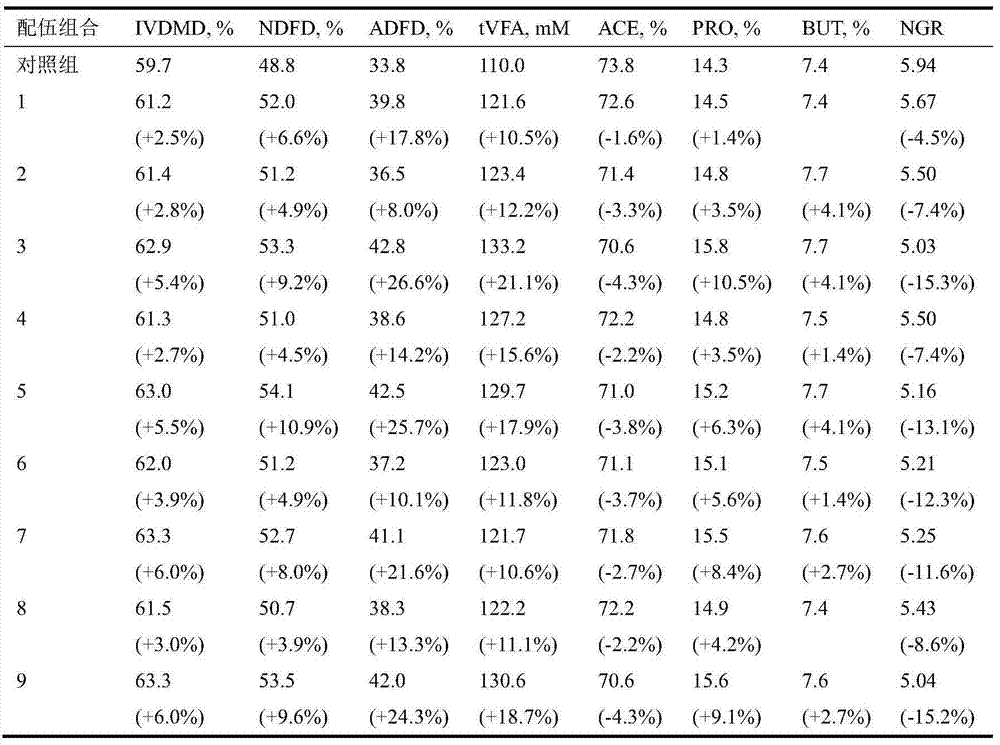Complex fungicide for improving feed fiber degradation rate and positively regulating rumen fermentation propionic acid generation as well as application thereof
A compound bacterial agent and positive regulation technology, which is applied in the field of livestock and poultry feed, can solve the problems such as the inability to achieve directional regulation and control of the production ratio, and achieve the effect of promoting energy utilization efficiency and improving fiber degradation rate
- Summary
- Abstract
- Description
- Claims
- Application Information
AI Technical Summary
Problems solved by technology
Method used
Image
Examples
Embodiment 1
[0018] Application effect analysis of compound microbial agent on dietary rumen microbial fiber degradation and gluconeogenesis precursor generation under the condition of high coarse material ratio
[0019] Three feed microorganisms, Bacillus subtilis (hereinafter referred to as BS), Candida utilis (hereinafter referred to as CU) and Enterococcus faecium (hereinafter referred to as EF), were used as feed microorganisms. 9 (3 3 ) Orthogonal table (Table 1) analyzed, tested and compared the combined effects of the three feed microbial compatibility additions. The bacterial agent of Bacillus subtilis used is light yellow solid powder, the moisture content is not higher than 8%, and the number of viable bacteria is not lower than 2×10 10 cfu / g dry weight; Candida utilis bacterial agent, white solid powder, moisture content not higher than 10%, viable count not lower than 4×10 9 cfu / g dry weight, Enterococcus faecium, white solid powder, moisture content not higher than 8%, viab...
Embodiment 2
[0032] Example 2: Analysis of the application effect of compound bacterial agent on the degradation of dietary rumen microbial fiber and the generation of gluconeogenesis precursors under the condition of low coarse material ratio
[0033] Lactating Holstein cows were used as experimental animals, Leymus chinensis and concentrate (each kilogram of concentrate contains: 404.7 grams of corn flour, 176.6 grams of soybean meal, 65.5 grams of rapeseed meal, 33.3 grams of cottonseed meal, 32.2 grams of expanded soybeans, sugar beet pulp 82.9 grams, 163.3 grams of cottonseed, 11.6 grams of stone powder, 7.2 grams of salt, 14.4 grams of baking soda, and 8.3 grams of premix) were prepared in a 30:70 ratio to prepare a low-coarse material ratio full mixed diet as a diet substrate, using an analytical balance Weigh 0.5 g of the dietary substrate into an anaerobic fermentation bottle. According to Table 1, add the corresponding Bacillus subtilis, Candida utilis and Enterococcus faecium of...
PUM
 Login to View More
Login to View More Abstract
Description
Claims
Application Information
 Login to View More
Login to View More - R&D
- Intellectual Property
- Life Sciences
- Materials
- Tech Scout
- Unparalleled Data Quality
- Higher Quality Content
- 60% Fewer Hallucinations
Browse by: Latest US Patents, China's latest patents, Technical Efficacy Thesaurus, Application Domain, Technology Topic, Popular Technical Reports.
© 2025 PatSnap. All rights reserved.Legal|Privacy policy|Modern Slavery Act Transparency Statement|Sitemap|About US| Contact US: help@patsnap.com



